PAGE 92a – December 2009 Mid-month Bonus Edition
HAPPY HOLIDAYS, EVERYONE!

In This Issue
Rails on the Acropolis—Little railway helps refurbish the Parthenon
Next to King Tut—Tiny tram helps excavate ancient Egyptian site
Buchstabennudelsuppenweisheit—A scrabble-lover’s layout
RR Crossing a Runway?!?—Who has the right of way?
The End of the Rat Hole—Puzzle switching in LA
Busy, Busy, Busy—Clever, perpetually working railway
Get Your Kids Involved—How-to article by Michael Skelly
Brio Goes to College—Students’ puzzle project
‘Micro Lego’—Is It Possible?—Yup, here’s one now!
Un Arbe, Un Train—An unconventional exhibition layout
Simple Starter Shelf—Beginners layout in 3 scales
My Favorite 2009 Layouts—Vote for your favorite layouts this year!
P.S. Gumby’s Model Railroad—Another celebrity reveals train love!
Looking over the layouts in the 2009 Scrapbook pages, I’m delighted at how pleasurable they are to view and operate. You might want to take a look—from #81 to #92a—then tell us which layout(s) you like best (see note at the bottom of this page). Help us find out what our world-wide readers really like!
Of course, some layouts and ideas are “special.” They tickle our funny bones, appeal to our aesthetic senses, or have some wildly inventive idea behind them. Often those ideas also appeal to kids—the future of our hobby. For all these reasons, I’ve reserved a few items for our last issue of 2009. Unleash your Sense of Wonder and enjoy these “special” railways!
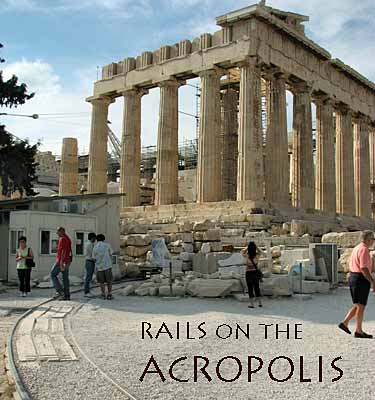
Photo: Scot Osterweil
A very special real-life railway is this one, which serves the Acropolis Restoration Project to restore the Parthenon in Athens, Greece. This 2,500-year-old structure has been under renovation since 1975, and a little meter-gauge railway is an integral part of the project. It transports both equipment and materials (mostly white marble) to the site. What an amazing prototype for a small display layout!
Two readers—Briton Peter Taylor and American Scot Osterweil—each supplied vacation photographs of the rail line and the restoration work. The aerial view from Bing Maps (below left) shows the route, beginning at the right where a hoist transfers stone and equipment from road transport to the rail cars. The track then skirts along the top of the acropolis wall, providing a perfect prototype for a decorated layout base! It eventually makes a right-angle turn toward the Parthenon and comes to an end at the track base of a movable gantry crane (lower right). The railway is essentially level throughout. Neither Peter nor Scot could spot any locomotive power, but Scot did find a flat car (lower left) at the Parthenon end of the line.
Photo: Bing Maps
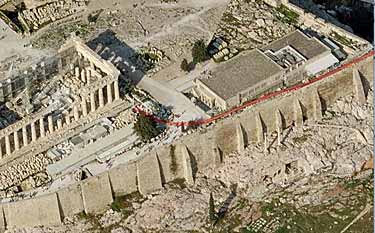
Photo: Scot Osterweil
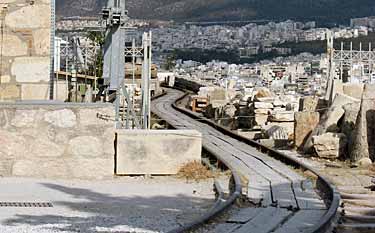
The aerial view of the Acropolis shows the whole line, which would make a stunning 36x16in micro layout! The Parthenon is much too large to be fully modelled in a micro format (it’s 69.5×30.9m/228x111ft and 13.7m/45ft high)… but the near corner could be modeled handily and perhaps continued on the backdrop. For starters, there’s an excellent free paper model available online. A hidden cassette at the right could feed loaded and unloaded cars to the line, and a real modelling challenge might be to build a working gantry crane alongside the Parthenon (prototype is below right).
As for operations, Peter commented, “The current Acropolis restoration involves removing stones that were either badly restored or put in the wrong place during previous works as well as the addition of new pieces, so the trackway could have a variety of goods in/out and also the probability of waste chippings being moved away from the site. Added to this is the fact that the building is illuminated at night, and clearly it could be developed into a working layout that looks good even when it is not being used.” Special? I think so!
Photo: Scot Osterweil
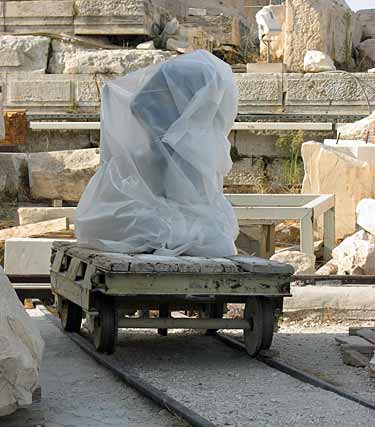
Photo: Peter Taylor
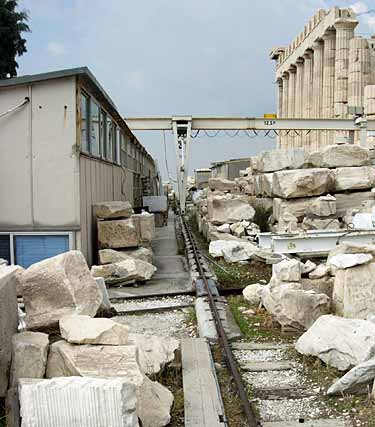
Photo: Peter Taylor
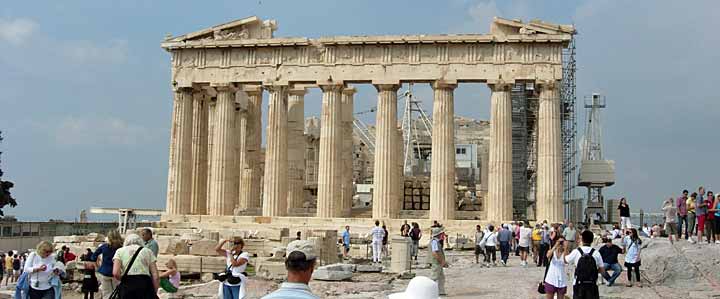
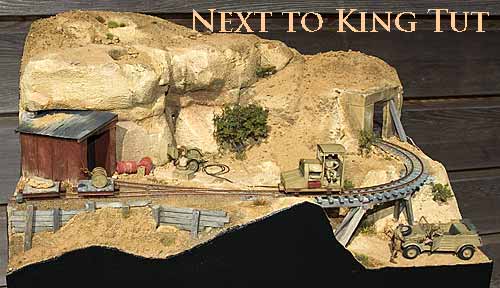
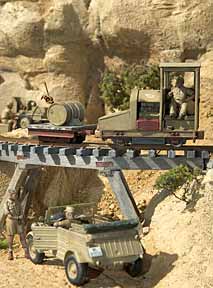
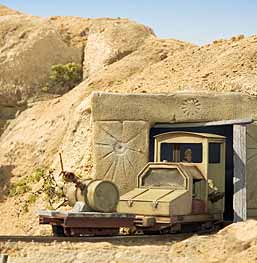
Straight from the movie “Indiana Jones and the Raiders of the Lost Ark” comes another modern layout with ties to antiquity: Tanis 1937. Will Vale, from Wellington, New Zealand, built it in 1:48 (American O) scale running on 9mm gauge, representing a Decauville-style tram railway (16in or 400mm gauge). The layout fits on a baseboard the size of an A3 sheet of paper… 420x297mm (16.5×11.7in).
It’s 1937, and a German archaeological team is toiling in the hot Egyptian sun, excavating an ancient temple. They have not yet found the Ark of the Covenant. “The loco and rolling stock are scratchbuilt, as is the building,” Will explains, “and the figures and accessories are from Tamiya 1:48 scale military kits. Scenery is styrofoam covered in gesso and crushed soil and rock from my neighbourhood. The track plan is a point-to-point but the back of the loco shed conceals a return curve allowing continuous running. I think it demonstrates you can get quite a lot into a small area.”
The layout was premiered at the 2009 Railex Show in Wellington. Will estimates that its total cost at retail would be about $200 NZD (about $140 USD). For me this layout is special because of its exotic setting and connection with the Indiana Jones cycle, in addition to its impeccable craftsmanship. Further, its small size and low cost make it an available option for nearly every model rail. Will has more information and photos on his website.
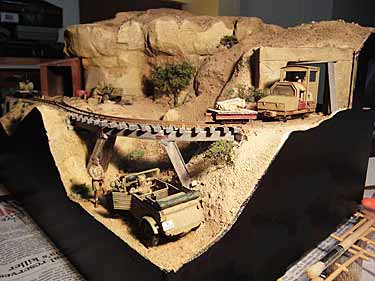
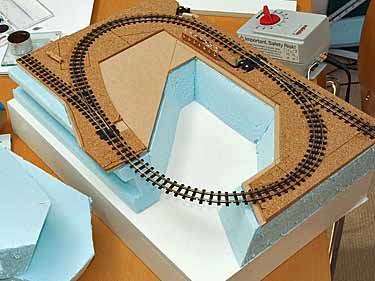
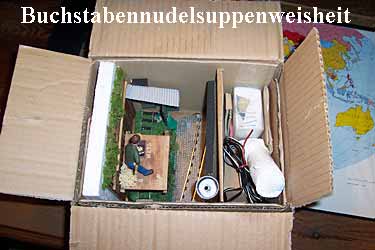
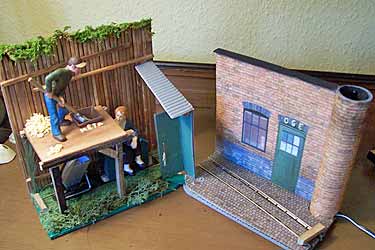
Frequent contributor Alexander Lehmann, from Mannheim, Germany, crafted this very small Gn15 layout at the request of two friends, Claudia and Reinhard Ose, who are artisans of jewelry and small metallic objects. They asked many of their friends to create miniature objects no larger than 15x15x15cm (6in cubed) for a miniature exhibition during December at their workshop in Bremen to help celebrate their 20th anniversary.
Naturally, even in Z scale an operating model railroad would seem impossible in such a tiny space, so Alex decided to make one in G scale—1:22.5! “After thinking about tightest possible curves,” explains Alex, “I came across the idea of the well-known Green End Quarry and remembered my own TT scale folding layout made for my brother Christian. And so I made a Gn15 scale folding layout, called Buchstabennudelsuppenweisheit (‘Alphabet Soup Wisdom’). In its folded state (above left) it measures 15x15x15cm. Unfolded, or swung open (above right), it measures 30×7½cm and is 15cm high.
“The hand-made line transports letters, taken from alphabet soup noodles before cooking. With the scenery comes a word puzzle. Remember the family name of my friends: Ose. Their work is involved with ideas, realizations, progressions and final results. There is always development. You might say their job is to ‘metamorphOse.’ So I invite you to have a very close look at the picture (below left)… this object is like a railway for scrabble players!”
Alex’s little railway is special to me because it demonstrates creativity and ingenuity in producing an operating large-scale layout in an extremely tiny space—and it crosses over into artistry, both in its execution and in its clever linguistic message!
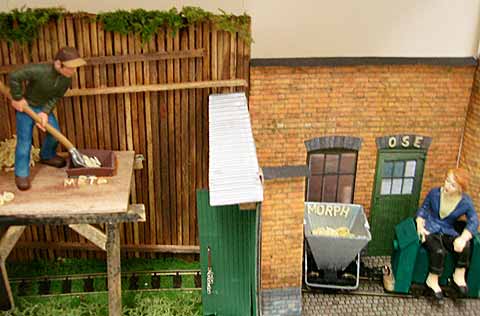
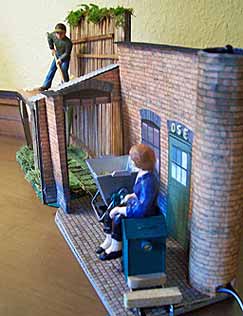
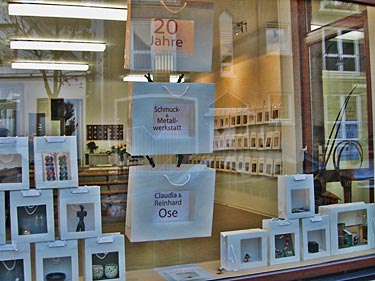
LATE UPDATE: As this Scrapbook is published, Alex’s little railway is on exhibit in the window of the Oses’ workshop in Bremen, along with other objects made by their friends. Claudia and Reinhard mounted each contribution in a paper bag display, then took the photo at left to show their anniversary exhibition. Alex’s Buchstabennudelsuppenweisheit is at the bottom right corner. The exhibition will continue until Christmas Eve 2009.
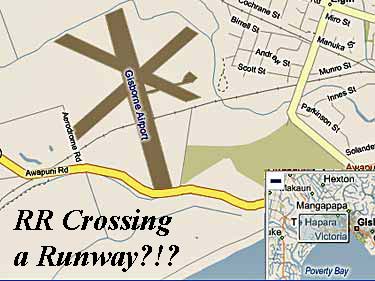
This strange story started when reader Max Sarazin, from Eastham, Cape Cod, Massachusetts, USA, wrote: “I have a pilot friend who was a railroad engineer in Italy during WW2. He tells of a railroad that crossed an airport runway for lack of space! When a plane asked for clearance to land, the tower operator had to make sure no train was coming. What an interesting micro or small railroad this would make with train, track, plane, hangar and tower.”
But alas, a few days later Max added, “My friend denies telling me about the train and runway; he’s in his mid nineties. We are both in the same pilots’ club. But it would still make a great whimsical micro whether it’s true or not.”
If that were all, you would not be reading this now. But as it happens, the story is true… in fact, there may be two airports with runway-crossing railroads! The confirmed one, shown in a Multimap.com image, is at Gisborne on New Zealand’s North Island. According to Wikipedia, “A unique level crossing exists near Gisborne, in which the Palmerston North – Gisborne Line crosses one of Gisborne Airport’s runways. At a signal on either side of the runway, trains must stop and then telephone air traffic control to get permission to cross the runway.” This report is confirmed by several New Zealand websites.
Incredibly, there may also have been another level crossing of a runway at Havana, Cuba Airport! This report, from Diggs.com, is as yet unconfirmed: “One of the funniest I’ve seen is Havana, Cuba where there is a railroad track crossing the runway at mid-field. Yes, you guessed it, the crossing gates favor the runway, not the tracks (as if the train could stop quickly). It is funny to be rolling down the runway and get the bruuump noise and bounce like in your car. Just hope you don’t hear the train horn and see the thing coming at you, ’cause neither of you can stop in time! BTW, I’m an airline pilot (and have been for many years).” Can any readers confirm this report about Havana Airport?
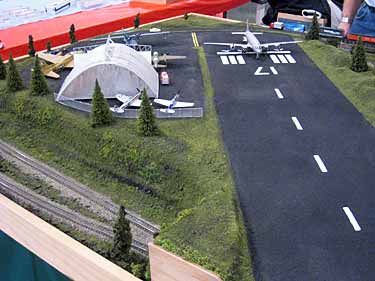
I think this idea fully qualifies as special. It is not only a ridiculous situation, but it has actually occurred in at least one airport around the world!
Incidentally, the situation is quite feasible to reproduce in model form. The photo (left) was snapped at a WGH train show in Puyallup, Washington last month. It’s part of the N-scale Joshua Junction & Jenniville, by Douglas Hoff, from Monroe, Washington, USA. Douglas, like many modelers, likes both trains and planes and has combined them by modeling an airport on his 6x10ft layout. In this case, the main line skirts behind the runway—but it certainly would be easy to extend the tarmac so the trains must actually cross it. Think of the additional operating possibilities that would arise!
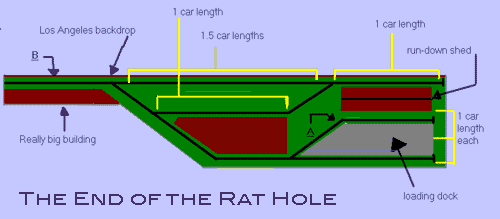
The relatively simple switching puzzle at the right was sent in by an anonymous reader. It’s set in the Southern Pacific’s notorious Rat Hole switching district that in days gone by twisted its way among tall brick buildings near downtown Los Angeles, USA.
The basic puzzle posed by Nonnymouse was to interchange two box cars positioned at A and B on the diagram, using a switcher initially parked on the passing siding (runaround loop). Readers of this page will likely be able to solve this one fairly quickly. (Hint: the lead track past B can be as long as you wish!) I immediately pointed out, however, that “using three boxcars makes the situation more interesting, and using four produces a ‘shove a tile into the empty spot’ type puzzle. Under those congested conditions, by assigning each car to a new spot one can produce a Timesaver type puzzle where the fastest solution wins.” Lots of fun in either case!
But obviously, the reason I find this little brain-tickler to be “special” is because of the setting. The Rat Hole, an urban warren of buildings, sidings, and switching chores, was a highly modelable place, as Bob Smaus has pointed out so well in the Model Railroader and on his website. This little layout can make a very compact version of the Rat Hole (including Smaus’s famous “curved building,” the Davies Warehouse, right in the middle). And it includes some good operating challenges as well. In HO or OO scales, using Atlas Snap or Peco Set Track switches, the little layout will fit on a 48x8in (120x20cm) shelf. Potent punch in a petite package!

This HO layout requires no introduction, no description, and no explanation of why I find it special. Just watch the video by clicking on the triangle below. Go ahead, we’ll wait!
This magic line was built by George Lermann, a member of the Metallbaukastenfreunde (“Friends of the Metallbaukasten”). This toy construction system would be called a Meccano set in the UK or an Erector Set in the US. When you cross a skilled model railroader with a devotee of metal construction sets, if you’re very lucky you will get something like the layout shown here! It was brought to my attention by Shortliner Jack Trollope, himself a skilled designer of similar very-busy-but-pointless railways in the Jaxcilli series— here, here and here.
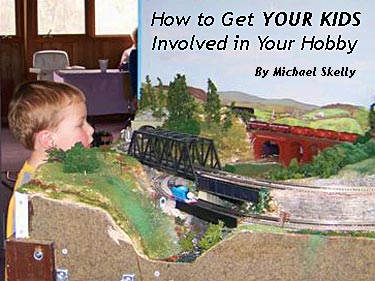
[Editor’s Note. The following article was written by Michael Skelly, from Bordentown, New Jersey, USA. Photos are from this website’s files. Mike wrote the article in response to a question posed on the Small Layout Design discussion group at Yahoo: “What are some things we can do to get our children interested in sharing our hobby?” I found Mike’s thoughts so special that I immediately sought his permission to republish his ideas here. He gladly gave the permission, commenting: “I hope the article brings more people together around something fun.” I share his hope and suspect that, after reading his comments, you will, too.
—Carl Arendt]
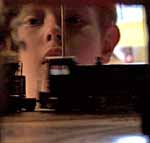
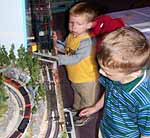
Have the railroad match the personalities and interests of your kids. If one of them is really rough on their other toys, build to a standard that can handle that. My two-year-old really enjoyed rerailing N scale trains down a plastic ramp (he was careful of the delicate equipment and his small hands were just the right size). His eight-year-old cousin was more like Godzilla, but calmed down a little bit when he controlled the trains. So we divided responsibilities. My son rerailed expendable trains I had selected, and his cousin controlled them with beefed up controls and simplified labels for switches. They were both supervised for safety by an adult at all times because it was a real electric-powered railroad.
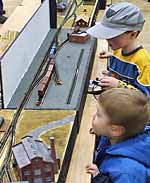
If one of your kids likes fast, noisy things, plan on at least one loop and have some flashing lights at crossings. If they like to arrange things or collect them, make sure to have an easily reached area that attracts model people (your kids can move the model people around and add to them) like a passenger station.
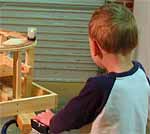 Planning and construction is a step that should not be missed by the kids. Make sure they get to discuss it with you. Let this part of the process take at least one overnight so they can “sleep on it.” It helps to make a scale diagram and a few scale cardboard pieces for buildings or trains, to let them try out different ideas without having to redraw everything each time. It may help to have a catalog of buildings and other items in your chosen scale to select from. This will cut down on the amount of scratch building too much imagination may call for. As the kids move around the scale pieces, they will get the idea of limited space very quickly. This can be treated as a puzzle. Encourage creativity. Show them Carl Arendt’s web site for some inspirations on how to get it done in a small space.
Planning and construction is a step that should not be missed by the kids. Make sure they get to discuss it with you. Let this part of the process take at least one overnight so they can “sleep on it.” It helps to make a scale diagram and a few scale cardboard pieces for buildings or trains, to let them try out different ideas without having to redraw everything each time. It may help to have a catalog of buildings and other items in your chosen scale to select from. This will cut down on the amount of scratch building too much imagination may call for. As the kids move around the scale pieces, they will get the idea of limited space very quickly. This can be treated as a puzzle. Encourage creativity. Show them Carl Arendt’s web site for some inspirations on how to get it done in a small space.
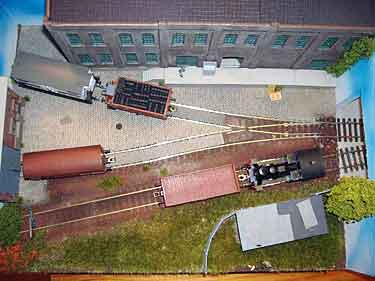
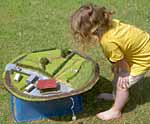
Construction can build a great sense of accomplishment and general understanding. Few moments in life beat hearing “I built that with my Dad.”
Go shopping for gloves, safety goggles and ear plugs. Everyone should use them. This makes it real and sets a good example.
Basic measurements can be shared between the kids. Cutting, drilling, and marking measurements are adult activities. Holding the other end of a piece of wood or other end of the measuring tape can be handled by the kids. Let them leave the job site (garage?) when they get tired and cranky. That’s when accidents and bad memories happen.
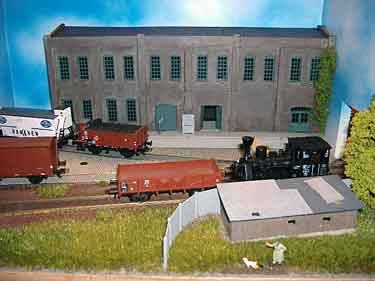
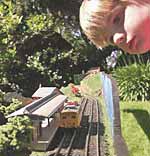
Scenery construction can be messy and fun too. Glue styrofoam blocks together and let the kids carve it up with kitchen utensils. Some Moms enjoy scenery construction. Include her if you can. A coat of latex paint with sprinkled-on scenery grass, etc., can be whipped up quickly. Use foam meat trays to create stone walls and Tunnel openings. A pen that has run out of ink can be used to scribe stones. Craft scissors can be used to cut the thin trays/stone walls to shape.
Later on, have Mom and each of the kids adopt a building or other feature of their own. Let them make as many decisions and take as many construction steps as possible. Give up super-detailing or rivet counting in the beginning. Don’t be surprised if Donald Duck or a recent fast food toy finds its way on to the layout. Keep it lively and interactive. Let each one pick an animated car such as a tipping logging car or tipping coal coal. This helps to slow the action down and keep it interesting at the same time.
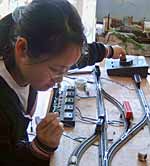
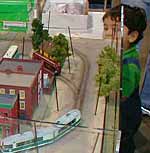
Pick themes that the older child will want to show off and share with other children their age. Eight to 10 years old is the beginning of more sociable kids. It’s OK to mix eras and purposes to build your kids’ skills and interests. A model spacecraft hung from a string overhead won’t really spoil the railroad. Also, suggest adding signs with meaningful names or humorous references that the kids and their friends select. If they are into video games there’s some good railroad games too.
A project like this can set your family on a course of shared interests for their full lives. Find the part that each child enjoys and let them take a larger part in that aspect. Not every modeler enjoys every aspect of modeling. Just like adults, interests do shift over time. Be willing to let go, or pick up the slack, as you all go along to make the best of it. It’s hard to capture this moment again (until you’re a grandparent).
Keep it small and easy to complete. Shelf layouts can be fun too. If the project is too large patience could disappear quickly. If it goes right the first time, they may be willing to go back and try another railroad. It doesn’t have to be the “final empire” the first time.
The main point is — keep it fun.
Used by Permission. Copyright © 2009 Michael Skelly, All Rights Reserved.
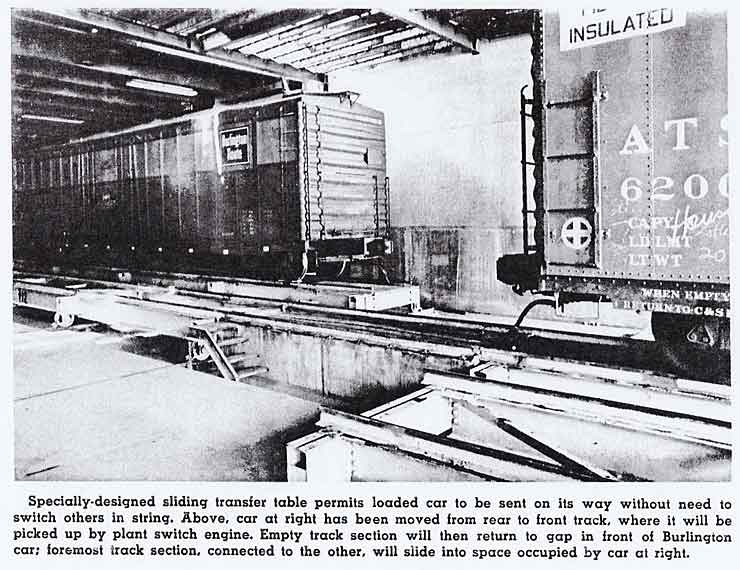
BRIO GOES TO COLLEGE
Another way to involve youngsters in the hobby is to make them test subjects! This “special” project is being performed by four students at HTL Donaustadt technical college in Vienna, Austria (inset photo). They are constructing a G-scale model of the Coors Traverser System (called A Keg of Coors on this site) and will write computer control software for the mathematical optimizations to minimize loco traffic on the system.
They also built a wooden mockup using standard, kid-proof Brio parts and conducted a feasibility study among six-year-old first graders in primary school. The kids’ task was to move a given amount of chocolate out of the Coors factory in minimum time (beer will be used when testing graduate students). One die per loading bay was used to determine when a hopper becomes full.
Herbert Feichtinger, the teacher who assigned the project, revealed results of the feasibility study: “The youngsters took about two to four minutes to move six pieces of chocolate. On average, girls (as always at this age) were faster than boys. Which leads to the following working theories:
– girls are better railroaders;
– at that age a female brain is ahead of a male one; or
– It’s just because of the chocolate.”
Ain’t science wonderful?! See why I think this project is special?
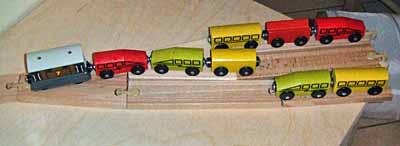
P.S. Speaking of wooden toy trains, Maurizio Melis, from Ferrara, Italy, has built a working Inglenook layout from Brio parts—not for his two-year-old son, but for himself! He writes, “YES! I can now enjoy operations even when the kid is around. No way to play with real HO stuff, he is able to destroy one train within seconds.” That’s Thomas’s friend, Toby the Tram, at the head end.
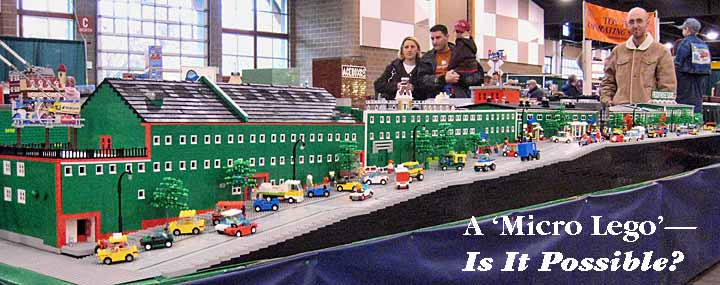
Yet another way to involve the younger generation is to join with them using toy trains and parts to build working layouts. In particular, LEGO blocks have an electric train system that is lots of fun for youngsters when they can get them away from Dad. Most train shows these days feature at least one giant LEGO train layout, usually designed and built by men over 50. A good example is our header photo, an impressive 14-foot (4.27 meter) long freight house made of LEGO parts and featured on a large LEGO train layout exhibited and photographed at a WGH Show a month ago.
But what about LEGO train layouts made by actual young people? I have an excellent example from Ryan Lamb, who lives in Madison, Wisconsin, USA and is 14 years old. He built a micro LEGO train layout (pictured below)! It measures 30x12in, and the trains and scenery are approximately 1:32 scale.
Ryan describes his project this way. “I have wanted a micro for a few years now. A few months ago, it dawned on me: A LEGO micro. I have lots of LEGO trains. I picked a small spot next to/above my bed, and started my railroad… The micro is basically a few sections of straight track leading up to a switch [a Fork]. Operations consist of swapping the cars’ places with the engine. But that is not the purpose of this layout. The purpose was to try LEGO scenery. The scenery consist of a large bridge, a road crossing, a vacant lot, and a boutique.”
Ryan felt that the layout’s simplicity might make operations too simple to hold interest. I pointed out that concocting a LEGO loader and/or unloader for the layout might spice things up a bit (a la the 7/8in scale fork layout I designed a few years ago). But I’m willing to wait and see Ryan’s next effort using LEGO trains with more operation. Meantime, I think his first micro layout is pretty special!
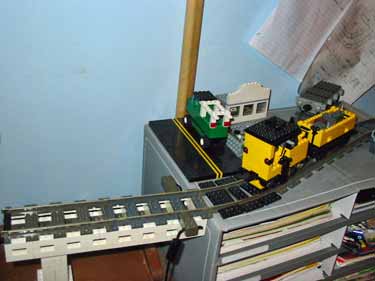
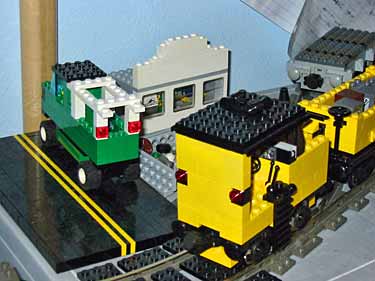
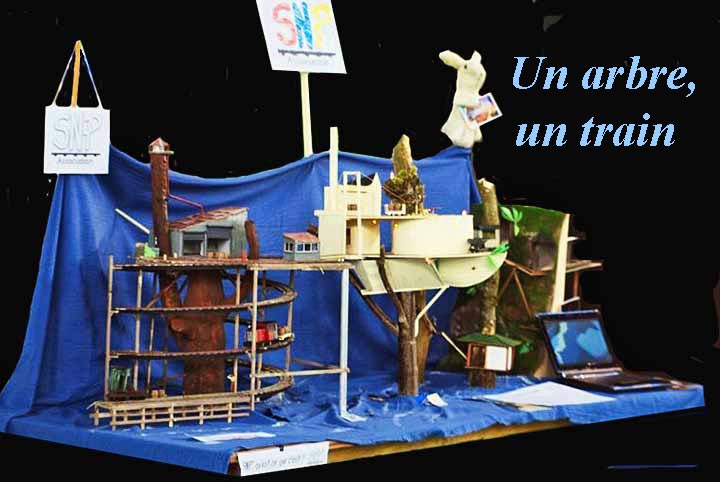
« Un arbre, un train » / “A tree, A train” … the theme of Expométrique 2009, the French annual narrow gauge train show held 6-7 June 2009. This theme ignited the imaginations of three young Frenchmen—Fabien Hallier, Jimmy Grondin and Benoît Evelin, from (in no particular order) Angoulème, Angers and Chartres. They form the shadowy SNP Association, who for the past few years have been producing highly imaginative layouts for French exhibitions. And this year: Nautica Sylvae Populi!
A tree with a train is one thing, they reasoned, but a train in a tree…. ? Their thoughts went “from the steampunk of Jules Verne (high-tech wood, wrought iron and steam) to the achievement of Hayao Miyazaki (Castle in the Sky, Spirited Away), to improbable forest structures with the complex roots of the mangrove tree … Nautica Sylvae Populi thus became the materialization of another world, where oil is not king and where the lifestyle is decidedly different from ours.”
There’s more of this train of thought at their website. The actual layout became a tiny 0e/On30 ore-handling line, using small diesels instead of steam locomotives, winding through the air among the trees as they haul ore from the mines down to the water, which forms the baseboard of the layout. Nautica Sylvae Populi is still growing and evolving—just as trees do.
It belongs to a special breed of fantasy layout that I find very attractive. Some others on this site from the genre are Andrew Milner’s Summit, based on Fantasonic Engineering’s Incredible Dizzying Heights Railroad that weaves through the air from cliff to cliff above the clouds; Chris Walas’s Submarine Pirates Cove, a steampunk haven with some aerial ideas of its own; and Jonathan Scott’s magical SpiritiNg Away, also inspired by Miyazaki’s amazing animations.
These layouts are not everyone’s preferred potion, but I submit they are a “special” breed and so deserve a place on this page.
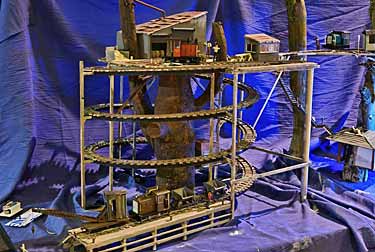
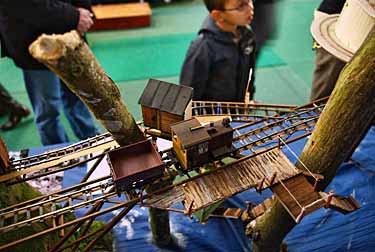

One school of micro layout design holds that the best approach is to have a very clear objective in mind, then pare away everything that doesn’t relate to that goal. The result should be an excellent, very small layout design! MJ Idzerda, from London, Ontario, Canada, followed exactly that philosophy in designing The Wallwort Co. Supply Railway. The result is a very simple railroad using minimal materials and scenery, that even a complete beginner can build quickly, ending up with a layout that is extraordinary fun to operate (i.e., to play with!).
MJ’s thought process went like this: “The idea came to me as I contemplated my 1×6 layout languishing under the sofa… I thought about why the layout was not being used or worked on and realized that it was a bit big, and needed to be much simpler, focusing exclusively on operation, needed minimal (almost nothing) scenery… and really could be just an operating diorama that is fun to use!!”
The result is a basic shelf measuring 48×7¼in (120x18cm), built on “a standard pine plank from the local wood folks.” It’s small enough literally to go anywhere, and is so simple and inexpensive that anyone can build it and have a good time. Scenery is minimal, with most of it relegated to the flat, computer-printed backdrops. MJ explains, ” It only took a few days to put this layout together; the printing of the backdrops proved the most time consuming. CG Textures was the site I used. I just made up whatever backdrop I wanted from their many samples, inserted it into Open Office Draw, printed to scale and I was done. The magic is that the backdrop can change to whatever I want, since it is only printer paper mounted with glue stick onto dollar-store foam core.”
And voilà! MJ has produced an ideal beginner’s layout… quick and easy to make, relatively cheap, and lots of fun to operate (it uses the Two Turnout Theme, celebrated in these pages as an excellent basic operating plan). While simple, MJ’s achievement here is pretty special!

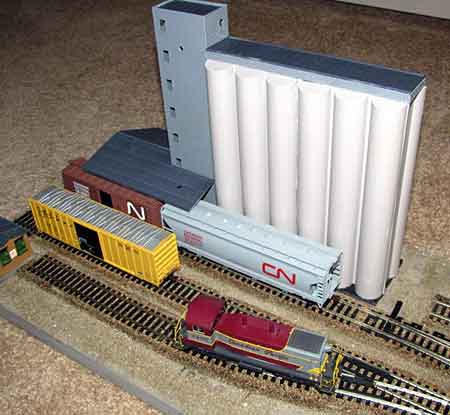
Inspirations for layouts are hard to pin down, but in MJ’s case he can tell us exactly where the idea for this layout came from. The two black and white photos below were taken 34 years apart, at Goderich, Ontario at the eastern edge of Lake Huron. The first shot (below left) was taken in 1974 and shows a basic switching yard with a very young MJ walking away from the camera along the lefthand track. The other shot (below right) was taken from roughly the same position in 2008, showing that both MJ and the Goderich Exeter Railway (GEXR) have grown considerably!
After realizing that this plan was ideal for many beginners to tackle, Carl Arendt drew it up in the three most popular scales—O three-rail, HO, and N—using Railmodeller software for the Macintosh. The plans are shown below, with lists of the sectional track required for each. All the plans require two right-hand and one left-hand turnout (unless you’re buildling a mirror image!), but the rest of the track could be either flex track or sectional track, your choice.
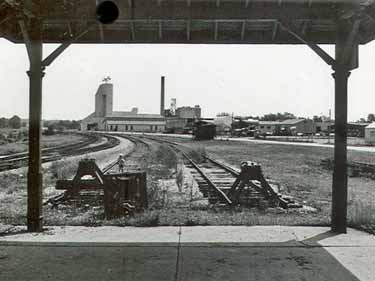
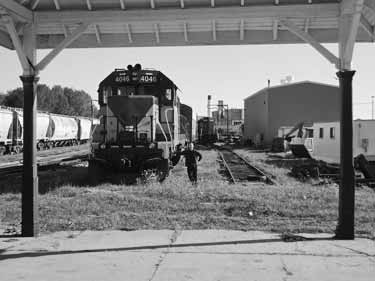
Plans and Parts Lists

This is an O scale, three-rail version of the plan, using Atlas-O track.
Parts List: 2x – O-54 Right Switch; 1x – O-54 Left Switch; 10x – 10in Straight; 3x – 4½in Straight (comes with turnouts); 2x – 1¾in Straight; 2x – 5½in Straight; 2x – 0-54 Half Curve; 1x – 0-54 Full Curve.

MJ’s HO/OO version uses Atlas Snap Switches (photo below). Peco Set Track can also be used, as here.
Peco Parts List: 2x – ST-240 right turnout; 1x – ST-241 left turnout; 11x – ST-200 standard straight; 2x – ST-202 79mm short straight; 2x – ST-203 41mm short straight; 4x – ST-222 half curve.

N scale plan uses Atlas Code 55 track for U.S. modelers. Peco or others could also be used.
Atlas Parts List: 2x – #5 right turnout; 1x – #5 left turnout; 8x – 4¼in straight; 2x – 3in straight; 1x – 2in straight; 1x – 1¼in straight; 2x – 71in rad. curve;

VOTE FOR YOUR FAVORITE LAYOUT(S) IN 2009!
Which layout(s) published in this Scrapbook during 2009 most appeal to you? Reader Nigel Beeton asked me that question, which prompted me to revisit all the 2009 issues—from #81 to #92a. It was a tough call, but I made my choices and will reveal them to you in the mid-January issue, along with a tabulation of all our readers’ preferences.
YOUR VOTE COUNTS… send us the names of your favorite 2009 layouts (no more than three per reader!) by emailing the names to layouts@micro-layouts.com before 10 January 2010. —Carl Arendt
Postscript: Now it can be told! Gumby is a model railroader (the latest of a string of celebrities who have confessed to ferroequinophilia — a love of iron horses)! Gumby and the gang use a variable-scale express train to bring them milk and cookies at break time. To see a YouTube video of Gumby’s model railroad, click on the photo at right. Thanks to Harry Rado, from Springfield, Virginia, USA for sending us this “special” link.


Leave a Reply